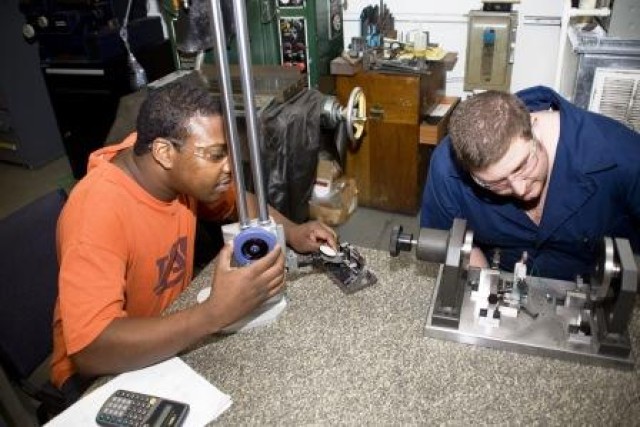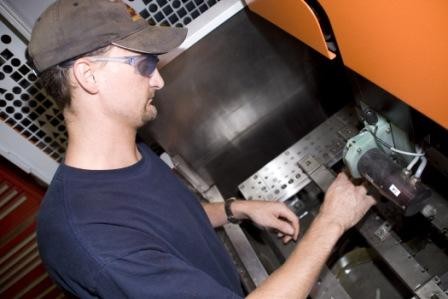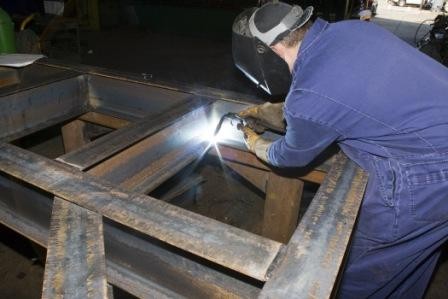ANNISTON ARMY DEPOT, Ala.-When one thinks of a public works organization on a maintenance depot, thoughts are probably directed to the air conditioning units, light bulb replacement and the upkeep of roads and grounds.
There's one division within the depot's Directorate of Public Works that keeps more than just the facilities running. The 36 people who make up the Fabrication and Repair Division are directly involved in the depot's overall mission to equip the warfighter.
Depot maintenance involves a lot of rebuilding. Tanks are taken apart. The components-engines, transmissions, electronics, upholstery, etc.-are repaired and then everything is put back together. It's the same for small arms and other weapons here.
Equipment is rebuilt to a like-new condition and sent back to the troops. And, many of the vehicles come off the line better than new when upgrades are incorporated.
Three directorates under the General Manager of Production Operations in the depot's Nichols Industrial Complex directly affect this 'rebuilding' process.
The depot's Directorate of Production is responsible for the hands-on repair and overhaul of the military equipment on the production lines. Directorate of Mission Plans and Operations is responsible for material movement and budget development for maintenance mission operations. Lastly, Directorate of Engineering and Quality personnel delve into the reengineering portion of depot maintenance, helping to design parts, tools and fixtures that improve the processes in DP.
F&R 'keeps it running'
All organizations on depot work together to ensure the depot is rebuilding equipment for the warfighters as efficiently and effectively as possible.
Inconspicuously, DPW's Fabrication and Repair Division, with its main office about eight miles from the industrial complex, is supporting the rebuilding process in its own way.
"We're a little jewel hidden out over here," said F&R supervisor Albert Tuck.
Employees in F&R are equipped with the skills and tools to fabricate parts, repair production equipment and do just about anything else the depot needs.
Each person in F&R might be described as a Jack-of-all-trades, which is somewhat a prerequisite since they never know what work will be coming their way.
"We take care of anything that has to be repaired quickly," said Tuck. "And, to keep everything running here, we have to have a variety of material."
Tuck said they hesitate to throw scrap metal and other leftover material away because F&R's work orders vary from week to week. One recent job for F&R was to make a track roller for the Paladin and FAASV production line. This fixture helps DP personnel roll up the tank tracks after the tracks are snapped off the tank and laid across the shop floor. The track roller is affixed to the forks of a forklift, and then through forward movement of the forklift, it helps guide the track into a rolled-up position.
Still, there are some toolmakers and welders within F&R that produce the same item each week.
Jesse Warmack fixes the "broke down" buggies that help DP haul the turrets and hulls in the tank rebuild process. David Magouyrk makes the anodes that welders in DP use for spot welding in the production of turbine engines.
Twenty percent of F&R's workload is made up of small arms gauges, according to Tuck. These parts help small arms repairers in DP check the precision of the weapons in the rebuild process. F&R helps them do that by working with the gauges to make sure the instruments calibrate the weapon.
Jesse Moon, toolmaker, said working on the small arms gauges might not be the job of choice for most people. "It's tedious work. It'll make you want to pull your hair out sometimes," he said.
Reengineering
Depot maintenance, for the most part, does not involve new production. The mission here requires work to be performed on military equipment that the original equipment manufacturers, or OEMs, aren't known to carry out.
The same company that first built the M1 main battle tank didn't build the tank the way that depot employees are required to rebuild it. The OEMs are dealing with new parts, so once components are placed on an assembly line, there aren't many surprises. That's not exactly the case at Army depots.
Because every vehicle is treated differently by the troops with regard to battle situations and theater landscape, depots must be ready to deal with the varying condition of each product coming to them for repair or overhaul work.
If special parts or tools needed to complete repair or assembly of a vehicle aren't readily available in the supply chain, the Directorate of Engineering and Quality and the Directorate of Public Works team up to meet the requirements.
Randy Houck is one of the engineers in DEQ who sees a lot of the products coming out of the F&R shop due to his involvement with the quality aspect of vehicle and weapon production. When it's determined that a certain tool is needed to improve the turnaround time in a production process, the depot tries to find it commercially.
A recent discovery in the reciprocating engine production process prompted action by DEQ and DPW. Mechanics needed modified snap ring pliers to help place the snap ring on the engine's turbo charger.
"What vendors were selling commercially just didn't meet the needs of the mechanics. They needed pliers with a long reach that could grab hold of the snap rings and close them," said Houck.
Houck worked with the engine mechanics in DP and with Jeff Thompson, a toolmaker in DPW, to design a set of snap ring pliers that would cut down on the time it takes to reassemble an engine. He said that F&R works with the different steels and hardening applications to bring the tool to life.
"We send the requests and drawings over there, and they help to modify the tools and fixtures. They're the reason the stuff works," said Houck.
In addition to DEQ engineers designing and reengineering parts for production operations, the F&R has its own mechanical engineering technician, John Durham, who can create manufacturing programs for the machines there.






Social Sharing